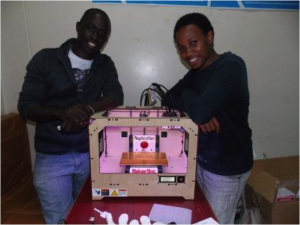Engineering Students Design “Happy Feet,” 3D Printed Shoes for Kenyans Afflicted by Jigger Infection
Many Americans have fairly filtered views of the dangers of living in other areas of the world; many people think of animal dangers in Kenya as being lions. While lion attacks are pretty unlikely, a much smaller creature affects 2.6 million people, including 1.5 million school-aged children. The jigger (or chigoe) flea can lead to some pretty terrible symptoms — jigger infections can cause sores, inflammation, secondary infections such as tetanus, and in advanced cases, even autoamputation of digits or death. Because these particular fleas aren’t gifted jumpers, the most commonly afflicted area is the foot.
Mechanical engineering student Roy Ombatti, a 23-year-old “critical thinker and social innovator,” was a finalist in the 3D4D Challenge, which seeks to use 3D printing for social good. Ombatti has an impressive CV: he co-founded the FabLab Nairobi Outreach Programme for kids, is a Stanford Fablearn Fellow 2014, a two-year International Development Design Summit alumus, and is an avid sportsman. Working with Harris Nyali, a 22-year-old mechanical engineering student at the University of Nairobi, he developed an original concept to use modern technology to better standards of living.
The concept is straightforward: those afflicted with jigger infections often have foot deformities, and this impacts their ability to walk. By creating specially made shoes, sufferers would remain mobile while also lessening their chances for re-infection. This is particularly important in an area with such high infection rates; over a 20-month period, around 50,000 students dropped out of school due to jigger infections. Furthermore, the conceptual design utilized recycled plastics, adding to the eco-friendly nature of the proposed shoes.
The Happy Feet project created a mobile lab that could go to areas where people need shoes, and where plastic bottles could be recycled into a filament for use in a 3D printer. The recycled PET from the bottles is extruded using a MakerBot Replicator 3D printer and crafted into shoes. Ombatti went to the Netherlands for a few months to study 3D printing and shoemaking, thanks to Baltan Laboratories and HIVOS, and gave workshops and exhibitions of his designs during Dutch Design Week.

While another project went on to win the 3D4D Challenge, Ombatti’s designs are part of a long-term initiative. According to a rundown on the projects video, the goals are to have an over-arching social impact:
- Social Impact
- Empower the Community
- Bring numbers of those infected down
- Create Green Jobs:
- Collection of plastic bottles
- Cleaning and Sorting
- Shoe printing business
- The youth can sustainably earn a living by printing and selling of shoes to Kenyans
The shoes from the Happy Feet project are ultimately useable not only by those with deformed, jigger-affected feet, but for anyone. Sustainable creation of custom-made shoes created from recycled materials could have a major impact on areas in rural Kenya where not everyone has access to correctly-fitted shoes. By 3D printing them using recycled plastics, the impact would be broad, allowing for not only shoes but also a cleaning of communities.
What do you think of the concept of 3D printed shoes? Let us know what you think of Ombatti’s shoes over at the Happy Feet 3D Printed Shoes forum thread on 3DPB.com. Check out this video of the original Happy Feet submission to the 3D4D Challenge (warning some graphic images of jigger infections):
Subscribe to Our Email Newsletter
Stay up-to-date on all the latest news from the 3D printing industry and receive information and offers from third party vendors.
You May Also Like
Precision at the Microscale: UK Researchers Advance Medical Devices with BMF’s 3D Printing Tech
University of Nottingham researchers are using Boston Micro Fabrication‘s (BMF) 3D printing technology to develop medical devices that improve compatibility with human tissue. Funded by a UK grant, this project...
3D Printing Webinar and Event Roundup: April 21, 2024
It’s another busy week of webinars and events, starting with Hannover Messe in Germany and continuing with Metalcasting Congress, Chinaplas, TechBlick’s Innovation Festival, and more. Stratasys continues its advanced training...
3D Printing Webinar and Event Roundup: March 17, 2024
It’s another busy week of webinars and events, including SALMED 2024 and AM Forum in Berlin. Stratasys continues its in-person training and is offering two webinars, ASTM is holding a...
3D Printed Micro Antenna is 15% Smaller and 6X Lighter
Horizon Microtechnologies has achieved success in creating a high-frequency D-Band horn antenna through micro 3D printing. However, this achievement did not rely solely on 3D printing; it involved a combination...































